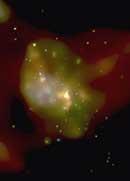Black hole in the milky way

On
October 26 of last year, a small dark spot in the constellation of Sagittarius in our galaxy emitted a short and intense x-ray light into space. This made it known to physicists that it could be a black hole in the milky way itself. Although they speak again and again of black holes in complete normalcy, so far no one has been able to demonstrate their existence.
The length and location of the X-ray emission of that day can be an important proof of the existence of a black hole in the heart of our galaxy, since, according to astronomer Fulvio Melia of the University of Arizona, there are no known objects that can emit this type of light in the universe. According to experts, this glow could have occurred by absorbing a comet through the black hole.
Astronomers know that the central part of our galaxy, known as A Sagittarius, is 2.6 million times heavier than the sun. Hence its brightness, which lasted about three hours, with 10 minutes of rest. The return 10 minutes after the brightness disappeared would notice the size of A Sagittarius, which took 10 minutes to tour this area. It follows that this area has a width of less than 15 million km.
According to astrophysicists, the black hole occurs when a huge mass is compressed in a small place, resulting in a high density area. This black hole that has appeared in the milky way has been very important. However, although this observation has given a very solid proof, they have wanted to completely eliminate the doubt that has emerged from another source of splendor and next year Frederick Baganof, responsible for this first observation, has announced in the journal Nature this week its intention to reorient the observatory of Chandra to this area.
Buletina
Bidali zure helbide elektronikoa eta jaso asteroko buletina zure sarrera-ontzian











